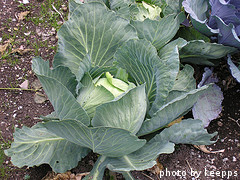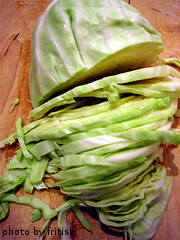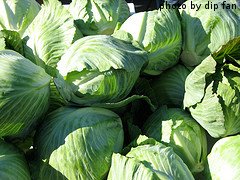Harvesting Cabbage - A How-To Guide
Before harvesting cabbage, it's important to make sure that the head is ready to be picked. The best way to determine if your head of cabbage is ready for harvesting is to squeeze it. Make sure the head is firm and doesn't give much when squeezed.
Sometimes, a cabbage plant will form a nice looking head that looks ready to be picked. However, looks can be deceiving. The leaves on the inside may be loose and flimsy. You can determine this by squeezing the head. If the head is a little soft and has some give to it, let it mature another couple of days. If it feels solid and tightly formed, it's probably ready to be picked.

Some varieties of cabbage have a narrow window of just a few days when they need to be picked. These are typically Chinese cabbage or other loose-leave varieties. Other varieties can sit in the garden for a couple of weeks without deteriorating, as long as the weather remains favorable. In general, the larger the cabbage variety, the longer they will hold up well while sitting on the plant, waiting for you to harvest them. This is especially true if the weather remains nice and cool. This is why we like to grow large cabbage varieties in the fall - they are much more forgiving when it comes to timing the harvest.
When harvesting cabbage, you'll need a sharp knife. Use the knife to cut through the stem, below the head. Take special care to cut the stem and not the bottom part of the head. This is especially important if you are planning to store your cabbage whole in a root cellar. Remove the head but leave the plant in the ground. Many times, in a couple of weeks, a smaller second head of cabbage will develop near the base of the harvested head. These extra heads of cabbage are more likely to form if the weather is still relatively cool after the main heads are harvested. These bonus heads are much smaller and less dense than the main head, but still taste great. When it comes to harvesting these bonus heads, you just have to use your best judgement about when they are ready. They won't form tight, firm heads.
In our own garden, we like to let the bonus heads grow and then we harvest them just before the first really hard freeze is expected. If you don't harvest them before a very hard freeze, the bonus heads can be damaged and they won't taste very good and the texture will be poor. We typically eat any bonus heads we get shortly after harvesting them, as they don't keep very well.

When you're done harvesting all of the cabbage, the plants can be pulled up and added to your compost pile. We like to chop up the plants first before adding them to our compost pile, just so they break down faster. We often use a powerful weed wacker to do the job. We also often give cabbage plants to our neighbors that keep rabbits.
Freshly harvested cabbage will store nicely in your refrigerator for 2-3 weeks, as long as you don't keep it in an airtight bag. Good airflow around the cabbage head will make it last longer.
If you have a good root cellar, whole cabbage heads can be kept for 3 months, sometimes more. If you're trying to store cabbage in a root cellar, it's best to keep as many leaves on the head as possible. The idea is the outer leaves will help protect the inside the cabbage. Also, cabbage will store better if you leave a longer stem attached to the head. If you store the cabbage head down and root end up, it will typically last much longer. In our own root cellar, we pack our heads of cabbage root side up in bins that are lined with straw. Once the cabbages are in the bins, we cover them with more straw, just so the stems are barely visible. We check on the cabbages in our root cellar a couple of times a week and if we see any signs of deterioration, we remove those heads immediately and cook them.
Raw cabbage generally is not good canned or frozen. If you have extra cabbage, you can use it to make sauerkraut, which will last for several months. You can also cook the cabbage and then freeze it. We like to make several trays of stuffed cabbage and then freeze those - they are a great way to store cabbage long term and they make easy, homecooked meals for days when we're just too busy to cook.
Now that you're harvested your cabbage, it's time for a few of our favorite cabbage recipes.

Click here for some of our favorite cabbage recipes
Click here to move from our Harvesting Cabbage page to our Growing Cabbage main page
Click here to go to our Home page